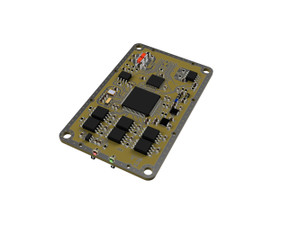
Eddie OBC
Spacemanic
Antelope on-board computer (OBC) is the combination of a Telemetry, Tracking & Command (TT&C) module and a Data Processing Unit (DPU). It is the powerful heart of the satellite, responsible for satellite control and basic task performance such as communication handling, monitoring the satellite's subsystems, handling the classic Fault Detection, Isolation and Recovery (FDIR) mechanism and performing planned tasks. Thanks to the powerful (160 GOPS) FPGA system it can also handle complicated on-board data processing tasks enabling Earth Observation (EO), telecommunication and other demanding data processing applications.
Antelope was designed to maximize spacecraft safety. Thanks to customised mechanisms which protect against effects related to space radiation it can be applicable in more demanding missions. An optional layer of security is provided by the machine learning algorithms which, on the basis of telemetric data, detect events which may be considered as threatening to the security of the mission. If such an event is detected, the computer will notify the operator in order to take corrective action.
Antelope is part of the Smart Mission Ecosystem – hardware, software and AI-powered algorithms designed to complete your mission.
| Parameter | Value |
|---|---|
| Form Factor | PC/104 |
| Operating System | 64-bit Linux (DPU), Oryx (TT&C) |
| SoC | Zynq UltraScale+ (DPU) |
| Processor | Hercules TMS570, ARM Cortex-R5F (TT&C) |
| Interface | SPI |
| Interface | RS422 |
| Interface | RS485 |
| Interface | CAN |
| Interface | I2C |
| Interface | GPIO |
| Interface | UART |
| Interface | SpaceWire |
| Interface | Ethernet |
| Interface | LVDS. |
| Memory | 1 to 4 GiB SLC flash-based filesystem storage - ECC protected |
| Memory | 1 to 2 GiB DDR4 - ECC protected |
| Memory | 12 MiB of MRAM |
| Memory | 256 kiB of FRAM |
Antelope on-board computer (OBC) is the combination of a Telemetry, Tracking & Command (TT&C) module and a Data Processing Unit (DPU). It is the powerful heart of the satellite, responsible for satellite control and basic task performance such as communication handling, monitoring the satellite's subsystems, handling the classic Fault Detection, Isolation and Recovery (FDIR) mechanism and performing planned tasks. Thanks to the powerful (160 GOPS) FPGA system it can also handle complicated on-board data processing tasks enabling Earth Observation (EO), telecommunication and other demanding data processing applications.
Antelope was designed to maximize spacecraft safety. Thanks to customised mechanisms which protect against effects related to space radiation it can be applicable in more demanding missions. An optional layer of security is provided by the machine learning algorithms which, on the basis of telemetric data, detect events which may be considered as threatening to the security of the mission. If such an event is detected, the computer will notify the operator in order to take corrective action.
Antelope is part of the Smart Mission Ecosystem – hardware, software and AI-powered algorithms designed to complete your mission.